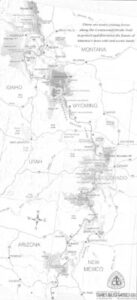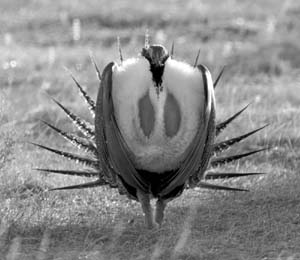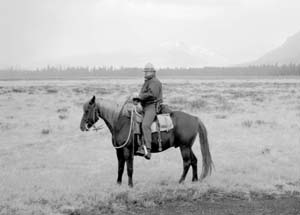A dozen Blackfeet Indians and one white man sit in an aspen grove up against the backbone of the world watching a horse die.
This is a land of spirits and portents. Things that happen here take on a heightened significance. The slow, agonizing death of an injured pack horse is not a sign to be ignored. The Thunder God is supposed to live in a cave up here, and he has little patience with blasphemers. As the Blackfeet and I sit in gloomy silence, I wonder if the Indians still worry about such things, and if they now think bringing in a white man was a big mistake. We have plenty of horses to carry packs and people, but I fear the trip is over.
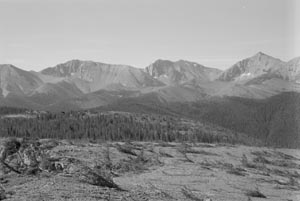
Suspicion can cut both ways. How could the Blackfeet, peerless equestrians of the northern plains, lose control of ahorse on a wilderness trail? Was it unavoidable or is it a sign that the Indians are not only losing their touch with horses but their fabled kinship with the natural world?
The backbone of the world runs along the Continental Divide from the Canadian border through northern Montana’s Glacier National Park to a place known as the Badger Two Medicine, where we are now. The Blackfeet call it the Badger – 130,000 acres of crags and peaks girdled by narrow, winding river valleys. The Indians lost ownership of the Badger just over 100 years ago in one of a series of deals made under duress that reduced the size of the tribe’s holdings to a fraction of the Blackfeet’s historic domain.
Many Blackfeet believe their destiny is still bound up with the Badger, because of its spiritual significance, its natural assets and mineral wealth. The mountains are, among other things, the principal source of fresh water for the tribe. Many of the Blackfeet creation stories are set in this place. The Blackfeet came here to practice their faith in secret after the Religious Crimes Code banned native observances in the 1880s. The mountain tops are dotted with crumbling stone shelters and shrines erected by the vision seekers who still come.
I am here as part of a journey to remote places along the Continental Divide to learn about the Blackfeet’s relationship to this land and to see if the old connections to the natural world are intact. For many years, white conservationists believed that the Blackfeet reverence for the Badger Two Medicine would protect it from commercial exploitation. However, the tribe no longer speaks with one voice when it comes to environmental matters. On the one hand are traditionalists who regard the Badger as a holy place. On the other are secular leaders who say that just as the faith of their ancestors failed to save the buffalo, it does little today to feed hungry children or lower a 60% unemployment rate.
In 1998, the tribal council leased thousands of acres of reservation land, some of it bordering the Badger, to two energy companies from Canada and Texas. Recently, three exploratory wells were drilled despite protests by the U.S. Environmental Protection Agency. The EPA argued that the drilling would displace wildlife that moves back and forth between the reservation and the mountains of the Badger Two Medicine.
The tribe, however, was paid $3 million for the drilling rights and it stands to make a great deal more if the wells are productive.
“We have the right to determine the destiny of our land, and no one knows its value or cares more about it than we do,” said William Old Chief, chairman of the Blackfeet Tribal Council, in response to the EPA’s criticism.
The Badger Two Medicine has also become a magnet for mechanized recreation. The strip of mountains is an important link in the Continental Divide National Scenic Trail connecting Glacier Park with the Bob Marshall Wilderness. Backpackers were joined by other, noisier travelers after the U.S. Forest Service opened that segment of the trail to all-terrain-vehicles and snowmobiles. Tribal spiritual leaders deplored the decision, saying that the blatting motors would scare off wildlife and vision seekers alike. But the machines make it possible for hunters and fishermen to reach remote places in a matter of hours that once took two or three days, and some Indians have joined the motorized throng.
There are no commercial outfitters among the Blackfeet leading pack trips into the Badger, and locating a guide is not easy. After several false starts, I find Terry Tatsey, a Blackfeet Community College administrator and rancher who is planning to take a group of family and friends on a horse trip into the Badger.
He is not surprised that I have had a hard time finding a guide. “People think because we are Blackfeet, we must know our way around the mountains. The truth is most people on the reservation have never been back in these mountains. The kids don’t know anything about the land. If you ask them where our water comes from, they’ll point to the faucet.”
Tatsey says he and his brothers were brought up to be at home in the mountains.
“Our grandfather took us back there several times a year. He showed us how to live off the plants and animals the way our ancestors did during the starvation times.” He is referring to the winter of 1884, the year the buffalo herds disappeared forever from the northern plains, the year that one-quarter of the tribe starved to death.
“We take people into the Badger at least once a year. We try to educate them about what’s back there and why it’s so much a part of our culture and religion.”
It is an arduous journey for those not accustomed to mountain travel, and Tatsey says that each year fewer people seem to be interested in making the trek.
“There are just a handful of us primitives left.”
Tatsey has arranged the trip to coincide with an educational encampment called The Learning Lodge, set up in a big meadow on the edge of the Badger. There are to be lectures on Blackfeet history, talks by tribal elders on Blackfeet traditions, songs and story telling. The annual gathering recalls a time, before the reservation, when nomadic bands of Blackfeet came together once a year to feast and dance, renew friendships and hold marriages.
As I arrive, several women are fixing dinner under a tarpaulin the size of a circus tent. They are cooking game on a huge cast iron grill. Nearby is a green, 400-gallon military surplus drinking water wagon. Tatsey’s 12-year-old daughter and a couple of friends lope their fathers’ horses, expertly wending their way through parked cars and tepees. They ride bareback, their long black hair flaring behind them like ravens’ wings. Quietly, a group of men carrying drums set up metal lawn chairs and seat themselves around a campfire and begin to chant.
The evening is spent feasting on fresh venison and fried bread listening to tribal linguists. They struggle to keep a quaintly pictorial language alive in an age of abstraction. Literally translated, a moose is “came into the clearing, black.” Hungry is “a jumping in the chest.” The newly coined phrase for a personal computer is “as you write, it prints.” Beer is “when you open it bubbles.” Many words and place names have no English equivalent and have never been translated. As native speakers die, a fund of knowledge dies with them. It is partly knowledge of native botany, of recipes for medicine prepared from ingredients found in places like the Badger Two Medicine
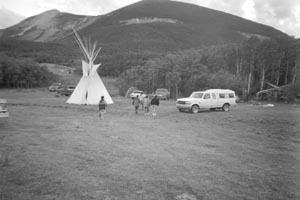
“You often find very practical reasons why people valued certain places. But to gain that knowledge you need the language. The map to the treasure is not always written in English,” said Darrell Kipp, who runs a school on the reservation that teaches only in the Blackfoot language. “As we lose our language, we lose our reverence for holy places, like the Badger.”
The Blackfeet sold the Badger Two Medicine in 1896. Repeated epidemics of smallpox and famine had reduced the tribe’s numbers from 15,000 to 2,000. The Blackfeet had been among the most formidable warriors on the northern plains. But by the end of the 19th century, they were no longer able to defend their land against armed miners and other trespassers.
After the buffalo were killed, the Blackfeet were forced to learn an alien mode of existence as farmers and ranchers. They had to have money to get started, and all they had to exchange for it was their land.
“We went along with the deal for the Badger because we were in despair,” Kipp said.
The Blackfeet had been lords of a realm that was twice the size of New England and extended from northern Saskatchewan to southern Montana. By 1900, their lands had been reduced to an area about half the size of Connecticut.
Limits beget conservation. The Blackfeet became zealous guardians of their own limited resources, espousing a modern conservation ethic and adopting a game code to ease hunting pressure on deer and elk herds. But agreeing to set limits is not the same as putting something off limits.
It is the difference between conservation and preservation, between the views of Indians and non-Indian environmentalists. Many Blackfeet, for example, want to hunt grizzly bears and bitterly resent the Endangered Species Act for making it a crime to shoot a grizzly.
“I call them “fuzzy pigs,” said Clyde Racine, of the bears.
“Blackfeet always hunted bears. It was part of our culture. Now, thanks to the Endangered Species Act, all we’re allowed to do is raise grizzly bears. And, we’ve raised a ton of them on this reservation in the last 20 years. Every year in the spring they come prowling down the creek bottoms, looking for cows and sheep to eat, scaring the kids to death.”
“This idea that bears are so sacred they shouldn’t be killed is strictly white man’s thinking. Live on an Indian reservation and you’ll have to make up your mind pretty quick which is more sacred, the grizzly bear or the human stomach. If we had a hunt here, we could sell licenses that would generate thousands of dollars for the tribe. Some of that money could go to feeding hungry kids, and we’ve got a lot of them.”
The Blackfeet have always killed grizzly bears, but they have also venerated them, believing that the bears and most other animals were messengers from the spirit world.
“The Great Spirit is in everything, animating trees, rocks, rivers, even storms. Our natives had much faith in this truest form of religion, because our holy beings can be seen with our naked eyes,” wrote Percy Bullchild in his 1985 book about Blackfeet religion. In Blackfeet mythology, humans frequently seek out animals to acquire their wisdom and power.
The relics that can be found on the high places of the Badger Two Medicine mark where people have gone to fast and pray in hopes that a great bear, or another spirit messenger, will appear in a dream and impart some of its strength or cunning.
The complex cosmology of the Blackfeet is reflected in the stories of the Badger Two Medicine, a place people have depended on for both spiritual and physical sustenance, where they come to harvest and to pray, to kill wild animals as well as to learn from them.
Preparing for the trip into the wilderness, Tatsey describes the route he has chosen into the badger. We will ride about 20 miles to a place called Ropes-Tie-Banks-Together, near the Continental Divide, where the Blackfeet used to trap buffalo in a stream. The place has been a favorite camping spot of the Tatsey family for nearly a century. A sweat lodge has been built near the campsite where we are to spend our first night on the trail.
Tatsey warns that things may be a little rough at the start. He is going to be breaking in a new packhorse on the trail. The animal has never been ridden, never had anything tied to its back, and now it is going to be made to carry 150 pounds of camping equipment.
Tatsey rides well ahead with the packhorse in tow. He wants to see how things go on the trail and thinks it prudent to keep some distance between the skittish horse and the rest of the livestock.
Leaving the encampment, we enter a dense forest carpeted with blue and purple wildflowers. We are in one of those intersections of nature where the land is a mosaic of geologic features not usually found near each other. Here, the northern plains, dotted with glacial ponds and furrowed by rivers, roll up abruptly against steep mountains fringed with aspen, balsam and cottonwood. Botanists call the complex an aspen parkland biome. It exists almost nowhere except along a 50-mile corridor between the Blackfeet Reservation and the Rocky Mountain front. An abundance of food, water and cover make for some of the best wildlife habitat in the northern Rockies. It also may harbor one of the largest untapped pools of natural gas in the Northwest.
We have traveled about a mile when word filters back that there had been an accident. The packhorse is down and hurt. “Fell on a beaver cutting,” someone says. Ahead, two girls are standing on one side of the downed horse, sobbing. The beaver cutting looks like a punji stake covered with blood. It is actually the butt of an aspen sapling that a beaver has chewed to a lethal point.. The horse, frantically trying to get free of its load, had been throwing itself from side to side, and had managed to impale itself on the aspen stake. Now, the horse is lying on its side, its feet lashed to a tree, held down by four men as Tatsey attempts to sew up a gaping wound in its flank. He is not having much success.
Every time he makes a little progress with the needle and thread, the horse thrashes violently and a slick, ghastly globe of intestine pops out of the hole in its flank. Again and again, Tatsey plunges both hands into the wound and tries to push the viscera back inside. This goes on for nearly a half-an-hour. Then, the blob of horse gut deflates, a clear sign that the intestine itself has developed a puncture. The horse stops struggling. Its respiration changes from anguished heaving to a shallow rattle. It is going into to shock. Tatsey lays aside the needle and thread, looks for a long moment at the wounded horse and turns to his cousin, one of the men holding the horse down. “Better get the gun, Squee.”
A tall heavyset man, Francis “Squee” Guardipe, gets to his feet and starts walking back toward the encampment. Several minutes later, he returns carrying a holstered .44 Magnum pistol, which he places on the ground near Tatsey. The men here are all familiar with guns, but nobody wants to be one the one to pull the trigger, not Squee, not Tatsey, not Marlin Spoonhunter, Tatsey’s Arapaho brother-in-law, not Tyson Running Wolf, not me. Finally, Joey Tatsey, Terry’s nephew and the youngest man present, reaches for the gun. “OK,” he said. “Let’s get it over with.”
Afterward, we pick up the packs and lead the other horses back toward the trail head. I grab up one end of a pack that Tyson Running Wolf is dragging down the trail. It is bulky and hard to get a grip on. Running Wolf, who has been struggling with his emotions, is angry at Tatsey for taking the untrained horse.
“Dumb Indians. Right? Always screwing up. That what you’re thinking”? he says to me. “You don’t bring a green horse like that, load him up and lead him into these mountains. This is no place to take an unbroke horse. These guys should know that. They’ve been around horses all their lives. There is no excuse for this happening.
“I’m getting out,” he says. “I’m pulling my horses. I don’t want anything more to do with this outfit.”
For Tatsey, losing the horse is just the latest setback in a long, unhappy year. He has spent much of it on lonely drives back and forth to Seattle where is wife is being treated for leukemia and waiting for a bone marrow transplant.
“It was a bad thing that happened today,” he says, emerging from the woods. “It’s kind of put a cloud over everything we are trying to do here. I know it makes us look like we don’t know what we are doing out here. You’ll have to judge that for yourself.”
Tatsey says the trip cannot go as planned. The attempt to strengthen the age-old bond between a group of Blackfeet and the world of their ancestors will have to wait another year.
Then, he explains how the Blackfeet seek to find consolation from the horse’s death.
“Losing an animal is part of life. It helps you prepare for losing loved ones. We believe that when an animal dies, often, it is taking the place of a person, in other words, so that person doesn’t have to die. We always try to be thankful that the death didn’t happen to our immediate family or to a good friend. In our way of life, nothing really dies anyway. Spiritually, it’s all still there. Like with that horse. We’re going to burn up the remains because we don’t want it attracting bears. But the spirit of the horse will be intact.”
Later, Tatsey, his daughter and brother-in-law, Marlin Spoonhunter walk into the woods carrying a can of white gas and a box of matches.
They march solemnly back to the site of the accident and pile branches and twigs on top of the dead horse.
Tatsey lights the pyre and asks Spoonhunter to say a prayer.
“Grandfather, we ask your forgiveness for what happened here today, and we ask that you send this horse’s spirit to watch over our horse herds. We ask your blessing on all our family members, old people, children and infants. We ask your blessing on our people who are sick. We thank you, Grandfather, for all of the animate and inanimate things on earth.”
Then, they perform a “smudge,” a brief purification rite in which they cleanse their faces with the smoke from a burning tuft of vanilla grass.
Tatsey’s daughter wants assurance from the adults that some good has come from the horse’s death.
“Do you think he saved another life”? she asks. “Maybe, he saved Mom’s life.”
“Maybe, so, my girl,” Tatsey says quietly. “Maybe so.”
©2001 Frank Clifford
Frank Clifford, an environmental writer for the Los Angeles Times, is researching the Continental Divide Trail.

